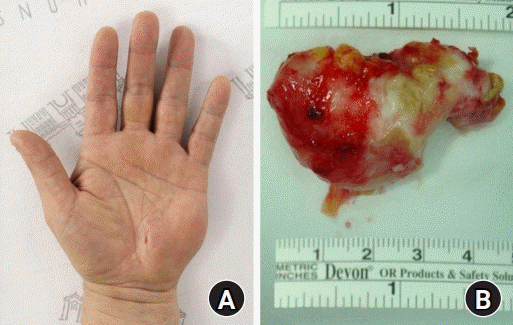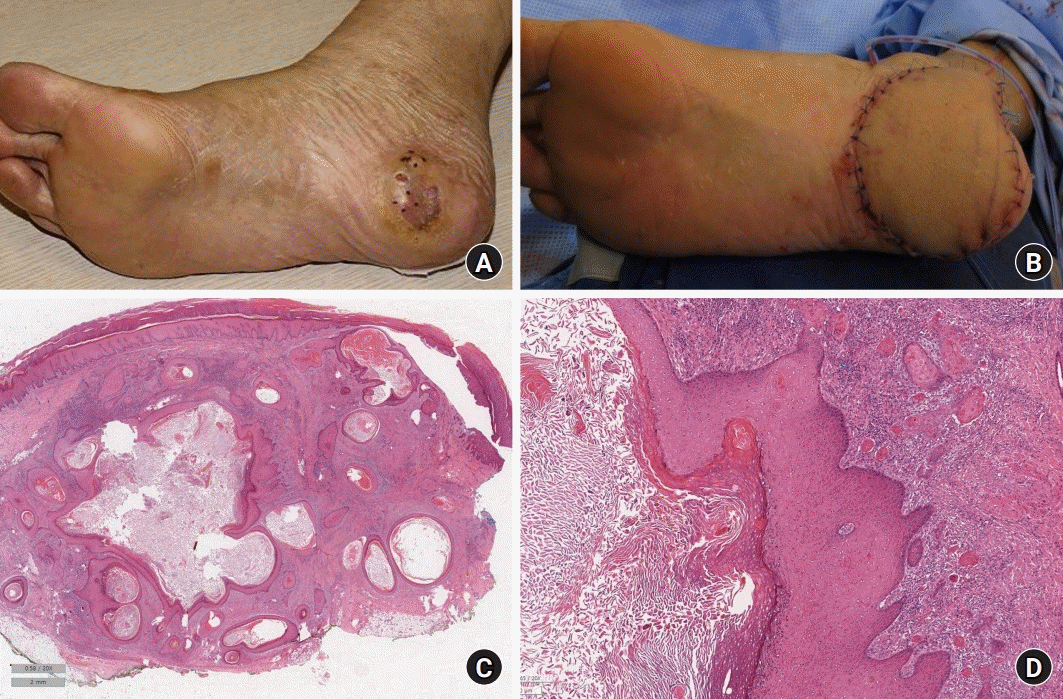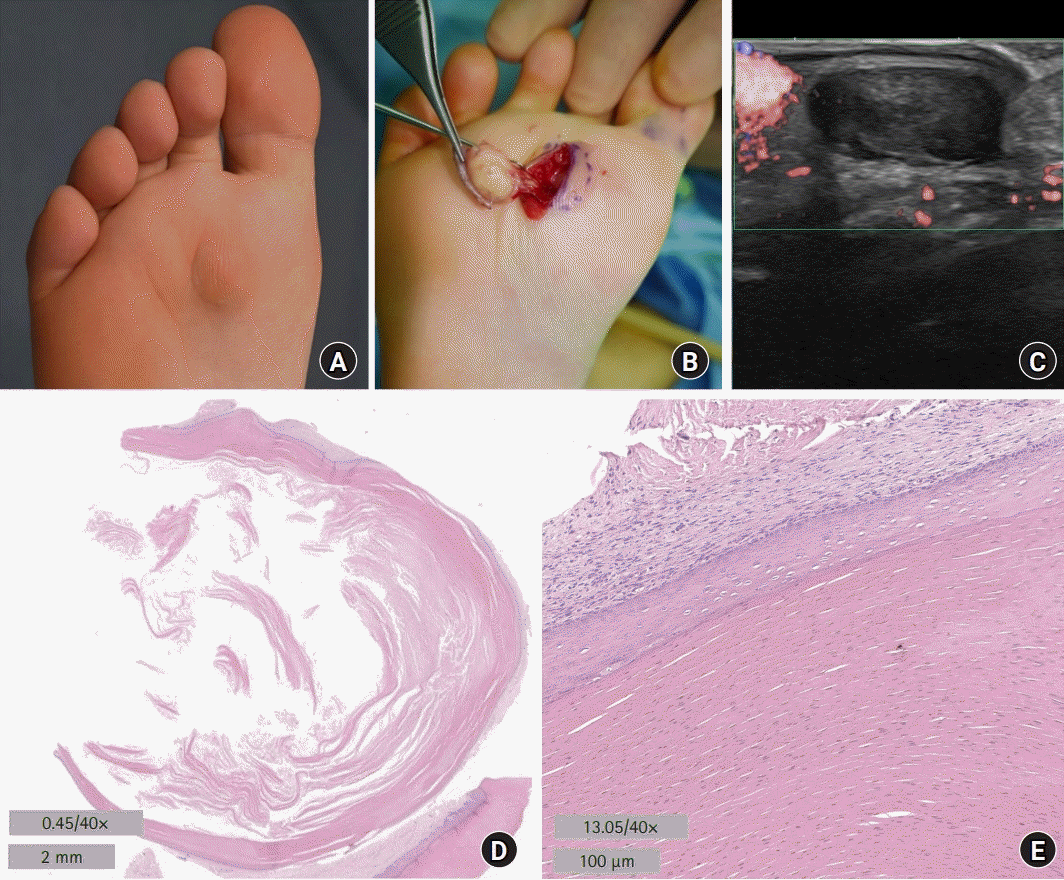1. Hoang VT, Trinh CT, Nguyen CH, Chansomphou V, Chansomphou V, Tran TT. Overview of epidermoid cyst. Eur J Radiol Open. 2019; 6:291–301.

2. Fisher BK, Macpherson M. Epidermoid cyst of the sole. J Am Acad Dermatol. 1986; 15(5 Pt 2):1127–9.

3. Hong SH, Chung HW, Choi JY, Koh YH, Choi JA, Kang HS. MRI findings of subcutaneous epidermal cysts: emphasis on the presence of rupture. AJR Am J Roentgenol. 2006; 186:961–6.

4. Koh KJ, Park HN, Kim KA. Gardner syndrome associated with multiple osteomas, intestinal polyposis, and epidermoid cysts. Imaging Sci Dent. 2016; 46:267–72.

5. Basterzi Y, Sari A, Ayhan S. Giant epidermoid cyst on the forefoot. Dermatol Surg. 2002; 28:639–40.

6. Ramakrishnaiah SB, Rajput SS, Gopinathan NS. Epidermoid cyst of the sole: a case report. J Clin Diagn Res. 2016; 10:PD06–7.
7. Arandes-Marcocci J, Melé-Ninot G, Quintana-Codina M, Iglesias-Sancho M, Salleras Redonnet M. Palmoplantar epidermoid cysts: two cases and brief review of the literature. Dermatol Online J. 2019; 25:13030/qt5s5557j7.
8. Craigen MA, Anderson EG. Traumatic epidermal inclusion cysts due to shoe impingement: a report of two cases. Foot Ankle. 1991; 11:239–41.

9. Egawa K, Honda Y, Inaba Y, Ono T, De Villiers EM. Detection of human papillomaviruses and eccrine ducts in palmoplantar epidermoid cysts. Br J Dermatol. 1995; 132:533–42.

10. Kato N, Ueno H. Two cases of plantar epidermal cyst associated with human papillomavirus. Clin Exp Dermatol. 1992; 17:252–6.

11. Yanagihara M, Sumi A, Mori S. Papillomavirus antigen in the epidermoid cyst of the sole: immunohistochemical and ultrastructural study. J Cutan Pathol. 1989; 16:375–81.
12. Park HS, Kim WS, Lee JH, et al. Association of human papillomavirus infection with palmoplantar epidermal cysts in Korean patients. Acta Derm Venereol. 2005; 85:404–8.

13. Antón-Badiola I, San Miguel-Fraile P, Peteiro-Cancelo A, Ortiz-Rey JA. [Squamous cell carcinoma arising on an epidermal inclusion cyst: a case presentation and review of the literature]. Actas Dermosifiliogr. 2010; 101:349–53. Spanish.

14. Veenstra JJ, Choudhry S, Krajenta RJ, Eide MJ. Squamous cell carcinoma originating from cutaneous cysts: the Henry Ford experience and review of the literature. J Dermatolog Treat. 2016; 27:95–8.

15. Kasahara R, Tajiri R, Kobayashi K, Yao M, Kitami K. Squamous cell carcinoma developing from a testicular epidermal cyst: a case report and literature review. Case Rep Urol. 2019; 2019:9014301.

16. Nigam JS, Bharti JN, Nair V, et al. Epidermal cysts: a clinicopathological analysis with emphasis on unusual findings. Int J Trichology. 2017; 9:108–12.

17. Shimizu Y, Sakita K, Arai E, et al. Clinicopathologic features of epidermal cysts of the sole: comparison with traditional epidermal cysts and trichilemmal cysts. J Cutan Pathol. 2005; 32:280–5.

18. Coulter PD, Bouché RT. Traumatically induced inclusion cyst secondary to shoe impingement: report of three cases. J Foot Ankle Surg. 1999; 38:271–7.

19. Kim HJ, Koh SH, Jung SW, Yang J, Lim H. Multiple epidermal cysts in the volar skin of the thumb. Arch Plast Surg. 2016; 43:303–5.

20. Egawa K, Kitasato H, Ono T. A palmar epidermoid cyst, showing histological features suggestive of eccrine duct origin, developing after a bee-sting. Br J Dermatol. 2000; 143:469–70.

21. Rios-Buceta LM, Fraga-Fernandez J, Fernandez-Herrera J. Human papillomavirus in an epidermoid cyst of the sole in a non-Japanese patient. J Am Acad Dermatol. 1992; 27(2 Pt 2):364–6.

22. Ghani S, Fazal MA. An unusual cause of intractable heel pain. J Foot Ankle Surg. 2011; 50:744–6.

23. Lincoski CJ, Bush DC, Millon SJ. Epidermoid cysts in the hand. J Hand Surg Eur Vol. 2009; 34:792–6.

24. Gomi M, Naito K, Obayashi O. A large epidermoid cyst developing in the palm: a case report. Int J Surg Case Rep. 2013; 4:773–7.

25. Saruta H, Ono F, Hamada T, et al. Multiple unilocular epidermal cysts presenting as a single lesion on the toe web. J Dermatol. 2013; 40:1052–4.

26. Faltaous AA, Leigh EC, Ray P, Wolbert TT. A rare transformation of epidermoid cyst into squamous cell carcinoma: a case report with literature review. Am J Case Rep. 2019; 20:1141–3.

27. Frank E, Macias D, Hondorp B, Kerstetter J, Inman JC. Incidental squamous cell carcinoma in an epidermal inclusion cyst: a case report and review of the literature. Case Rep Dermatol. 2018; 10:61–8.

28. Jehle KS, Shakir AJ, Sayegh ME. Squamous cell carcinoma arising in an epidermoid cyst. Br J Hosp Med (Lond). 2007; 68:446.

29. Vasiloudes PE, Morelli JG, Weston WL. Plantar epidermal cysts in children. Arch Dermatol. 1997; 133:1465.

30. Knight PJ, Reiner CB. Superficial lumps in children: what, when, and why? Pediatrics. 1983; 72:147–53.

31. Berlin SJ. A review of 2,720 lesions of the foot. J Am Podiatry Assoc. 1980; 70:318–24.

32. Janarthanam J, Mahadevan S. Epidermoid cyst of submandibular region. J Oral Maxillofac Pathol. 2012; 16:435–7.

33. Won JH, Lee MJ, Park JS, Chung H, Kim JK, Shim JS. Multiple epidermal cysts in lowe syndrome. Ann Dermatol. 2010; 22:444–6.








 PDF
PDF Citation
Citation Print
Print



 XML Download
XML Download